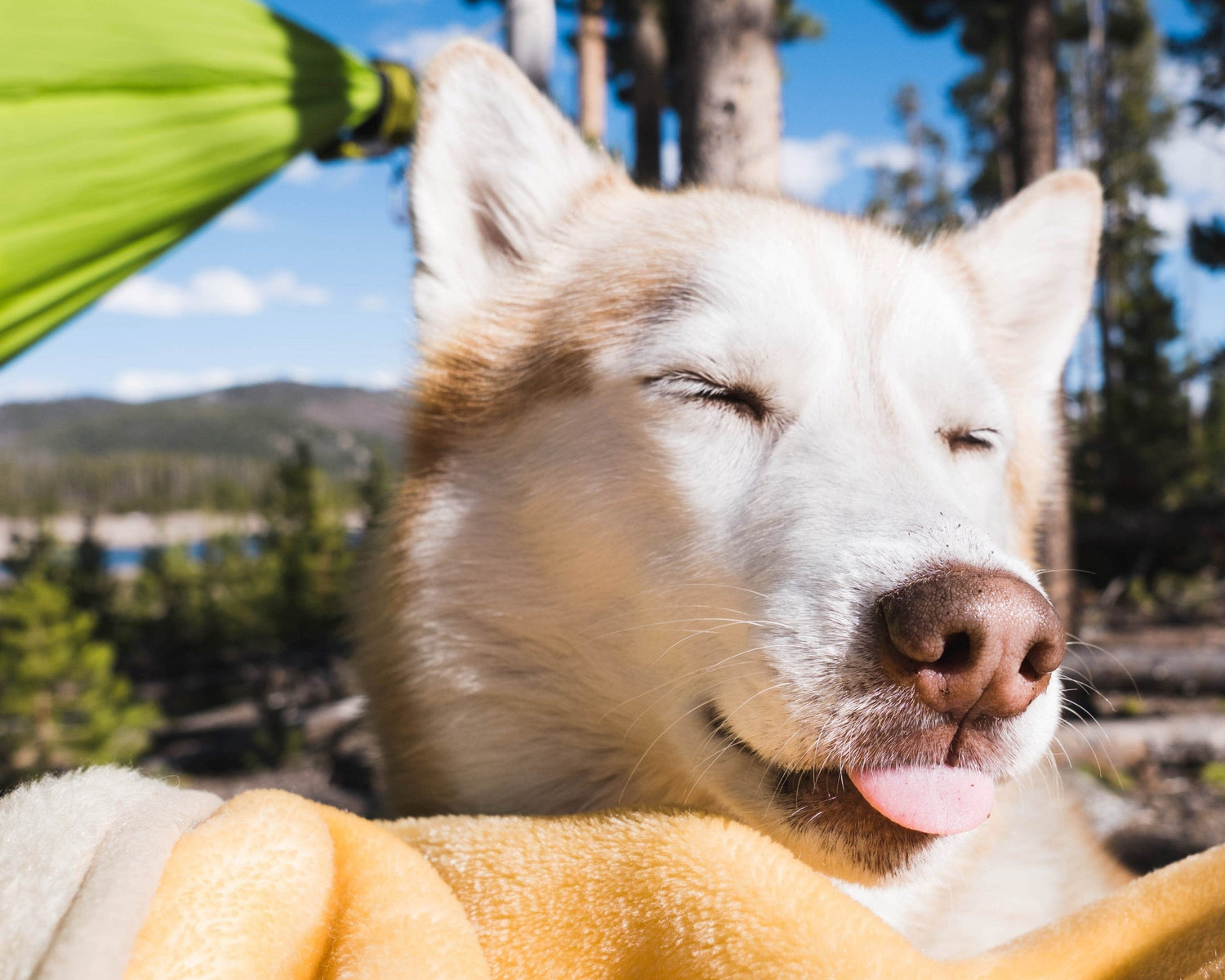Summer is here, and so are sunny days filled with exciting adventures! It's the best time to splash in cool pools, explore nature trails, or simply enjoying picnics with friends and family. There are so many ways to make the most of these warm months. For dog moms and dads, their sweet pup probably goes with them on these adventures as they explore new places and have water fights and build sandcastles at the beach. Summer is a time for laughter, new discoveries, and making new memories.
With the days getting longer and sunnier, sunscreen becomes needed for everyone - and you may wonder, can dogs get sunburned? Since you and your pup are likely to spend more time under the sun, you both need extra protection from those harmful sun rays.
Table of Contents
- What are the Benefits of Sun Exposure to Dogs?
- Can Dogs Get Sunburned?
- Which Dog Breeds are Most Likely to get Sunburned?
- What are the Risks of Sunburn on Dogs?
- What are the Symptoms of Sunburn on Dogs?
- What are Ways to Soothe a Sunburn on a Dog?
- How is Sunburn on Dogs Best Prevented?
- Should you put Sunscreen on Dogs?
- What if Dog Approved Sunscreen is not Handy?
What are the benefits of sun exposure to dogs?
Have you ever noticed how the dog always finds the best spot to relax? Other than the especially hot days of summer, dogs are usually found sleeping in the sun when they are outside. Dogs - and all mammals - have until until recent times spent most of their time outside. We all need some sun exposure, including our dog friends! There are so many benefits to sun exposure as our bodies are designed to utilize it for our health. Some of the many benefits include:
- Mood Booster: Sunshine helps humans and dogs alike to make serotonin, and it helps with mood, appetite, and sleep. Sunny days make sunny feelings!
- The Mighty Vitamin D: Dogs aren't able to get as much Vitamin D from the sun as we do, as their fur blocks much of the skin, but the sun is still helpful for the needed Vitamin D in addition to their food.
- Pain Relief: The warm sunlight can be a natural heat pack to loosen up sore muscles and stiff joints. Senior pups will especially appreciate this! For dogs with arthritis, our BestLife4Pets Walk-Easy Hip & Joint Pain Relief helps ease joint stiffness, reduce pain & inflammation.
-
Skin issues: Moderate sun exposure can help prevent certain skin conditions by killing bacteria and yeast on the skin and drying out damp areas of fur. Sunlight also helps dogs to produce their natural oils that help keep skin moisturized and healthy, which is especially helpful for dogs with dry or itchy skin.
- Sleep: late afternoon and evening sunlight helps dogs to sleep better as it helps melatonin production that helps keep sleep-wake cycles regular.
- Metabolism: Since sunlight helps with serotonin, that is also the hormone that helps to stay a healthy weight.
Can Dogs Get Sunburned?
So, can dogs get sunburned? Too much of a good thing, even the sunshine could be harmful. Whether you've planned a beach trip, a game of fetch at the dog park, or you're just taking your dog out for a daily walk; your dog will be exposed to plenty of sun. And yes, they can get sunburned.
Many pet parents think that a dog's fur protects their skin from all sun exposure, but this isn't accurate. While their fur does offer tremendous proactive benefits, it isn't a sun-proof layer that keeps the rays off their skin. Moreover, dogs also have areas in their body where there is little to no fur, like their ears, belly, and their nose. These parts may easily be damaged by the sun and get painful sunburns.
Which dog breeds are most likely to get sunburned?
Although all dog breeds require some form of protection before heading out on a sunny day, it's true that some breeds are more at risk of getting sunburned than others. The American Kennel Club states that hairless or short-haired dog breeds require a high level of sun protection if they're outside for long hours. Here are some of the breeds to be extra careful with under the sun:
- Pitbull
- American hairless terrier
- Weimaraner
- Greyhound
- Chinese crested
- Mexican hairless dog (Xoloitzcuintli)
Additionally, dogs with light-colored fur or thin coats should also be armed with sun protection, particularly around their noses and ears. These include the following breeds:
- Collie
- Dalmatian
- Australian sheepdog
- Bulldog
- Whippet
What are the risks of sunburn on dogs?
Sunburn in dogs isn’t just uncomfortable; it can be quite painful too. Think of the last time you may have had a sunburn. Do you remember how sore and tender your skin felt for the next few days? It's just as painful for your pup if they get sunburned! If your dog spends too much time in the sun without protection, they could get serious skin and health problems.
Some of the most common issues are:
- Sunburn - your dog can get sunburned too! The worse a burn is, the more risk of health issues it has for your dog. Severe sunburn is a result of not using sun protection for your dog, and it can cause pain, peeling skin, and blisters.
- Heat stroke - the mix of sunburn and sun exposure leaves your pup at risk of getting a heat stroke. Heat strokes occur when your dog's body temperature rises, causing weakness and fatigue. Continued heat strokes can put your dog at risk of serious health problems, so be sure to use sun protection and get medical treatment!
- Skin cancer - excessive sun exposure may also lead to skin cancer, which is just as true for dogs as it is for humans. Health conditions getting worse - UV rays can make some existing conditions worse, such as autoimmune disorders and canine dermatitis. By keeping your pup safe in the sun, you can prevent any new problems from popping up, as well as make sure they don’t get any worse.
What are the symptoms of sunburn on dogs?
If your pup shows any of these signs of a sunburn, it’s time to get them out of the sun fast. Here’s what you should look for:
- Tender skin - If you notice your furry best friend flinching whenever you pet them, it could be due to sunburn. Sunburned skin in dogs becomes tender and is quite painful to touch. You might also notice your dog feeling itchier than normal and whimpering while scratching a particular spot.
- Red or pink skin - Sun exposure can cause your dog's skin to become inflamed. Therefore, it would appear to be red or pinker than usual. Hair loss in one particular area of the skin.
- Scaly skin with blisters.
- Cracked and dry edges of the ears.
What are Ways to Soothe a Sunburn on a Dog?
For mild sunburns, there are many things a dog parent can do to ease the pain and discomfort at home. Most sunburns will heal on their own within a few days. While they are healing, you can give your pup extra care by:
- Oatmeal Bath: Soaking in an oatmeal bath is a great way to moisturize the skin and calm down the inflammation. There are oatmeal dog shampoos to buy, or you can make your own. Grind one cup of oats into powder and add to cool water in the bathtub. Have you pup soak for at least 10 minutes while you pour the water over your dog. Pat your dog dry, don't rub with the towel as it may hurt their burned skin.
- Cool water compresses: Cool water - not ice packs - on a washcloth or in a spray bottle will cool off the burned area and provide soothing.
- Aloe Vera: Aloe Vera gel is the human go to for sunburn and will soothe and heal a pup's sunburn too. As Aloe is toxic to dogs and can cause extreme stomach upset if eaten or licked off, try to be sure they cannot lick it off once applied.
- Honey: Although it is sticky, it is also very soothing to skin. Honey is safe as a sweet treat if they choose to lick it off, so enjoy treating their skin and taste buds with this remedy.
How is Sunburn on dogs best Prevented?
The best way to prevent a sunburn, is to prevent overexposure to the sun. There are many ways to help your pup to avoid the most harmful times of sun exposure, such as providing shade at peak hours between 10 am - 3 pm in the heat of summer.
Protective clothing is a fun way to keep your dog from too much sun exposure. Doggy sunglasses, hats, and other clothing are a cute way to prevent sunburn.
Don't give your long haired dog a trim before summer as the extra fur especially on the top of the head and back help prevent burns.
Should you put Sunscreen on Dogs?
As the answer to, “Can dogs get sunburned?” is YES, how do we protect them? Should you cancel all of your summer plans and spend these months stuck inside with your dog? Absolutely not! You and your pup deserve to have a blast this summer, and practicing smart sun exposure and using sunscreen will help you do it. Putting on sunscreen is just as important for your dog as it is for you.
There are numerous sunscreens for dogs out there, allowing you to protect your dog from sunburn and skin cancer without having to stay inside all day. They come as sprays, creams and balms, so you can choose what works best for you and your pup. We love the Sky and Sol Face and Body Sunscreen made with 7 natural, safe-for-you ingredients including beef tallow to nourish and protect your skin and your pups!
You should be putting sunscreen on your dog whenever they will be spending more than 20 minutes during peak hours in direct sunlight. Try to reapply the sunscreen every 3 hours to ensure its maximum effectiveness, especially if they are swimming. When it comes to putting on sunscreen, make sure you cover all of your dog's skin. It is super important to apply an extra layer to exposed areas or spots where the fur thins out for maximum protection. The most important areas to slather on the sunscreen are the snout, ears, face, lips, groin, and belly. Moreover, if your dog has a pink nose, you can apply some sunscreen there as well.
Even if the sunscreen is dog friendly, wait until heading off on the adventure to apply, as dogs want to lick anything new and are not likely to be licking and grooming while active.
If you have a dog with any missing fur, make sure to pay special attention to any patches where the fur has fallen out or has become thin. Our Healthy Skin & Coat + Dog Fur Regrowth formula will help with fur loss as it stimulates the skin, reduces scratching & itching to supports a glossy, healthy coat.
Always do a patch test first. No matter how popular a dog-safe sunscreen might be among pet parents, there are still chances of it causing an allergic reaction in your pup, and you definitely don't want to put your dog through that! Make it a practice to test a dollop of any new sunscreen on a small area of your dog's skin. Leave it on for half an hour and see if it causes a reaction or irritation before using it on their whole body.
What if Dog Approved Sunscreen is not Handy?
If you've run out of dog-safe sunscreen and you need to take your pup out for a while on a particularly sunny day, there are some things you should think about: Stepping out without sunscreen is definitely more dangerous than not using a pet-safe sunscreen. It leaves your pup exposed to UV rays, increasing the chances of heat strokes and sunburns.
If you don’t have sunscreen, pet care experts recommend using a sunscreen that is specially designed for babies. These sunscreens are generally SPF 15, making the formula gentle enough to be used on your dog. With any sunscreen, dog safe or not, be sure it is beyond access to your pup, as curious dogs love to explore by chewing and tasting. In large amounts, zinc oxide is toxic to dogs and can lead to anemia, so be sure to use only when necessary as pups have a tendency to lick everything. Also, avoid sunscreens with PABA (para-aminobenzoic acid) and artificial scents.
Enjoy the summer and abundant sunshine safely as you head off to your next adventure with your furry buddy!



